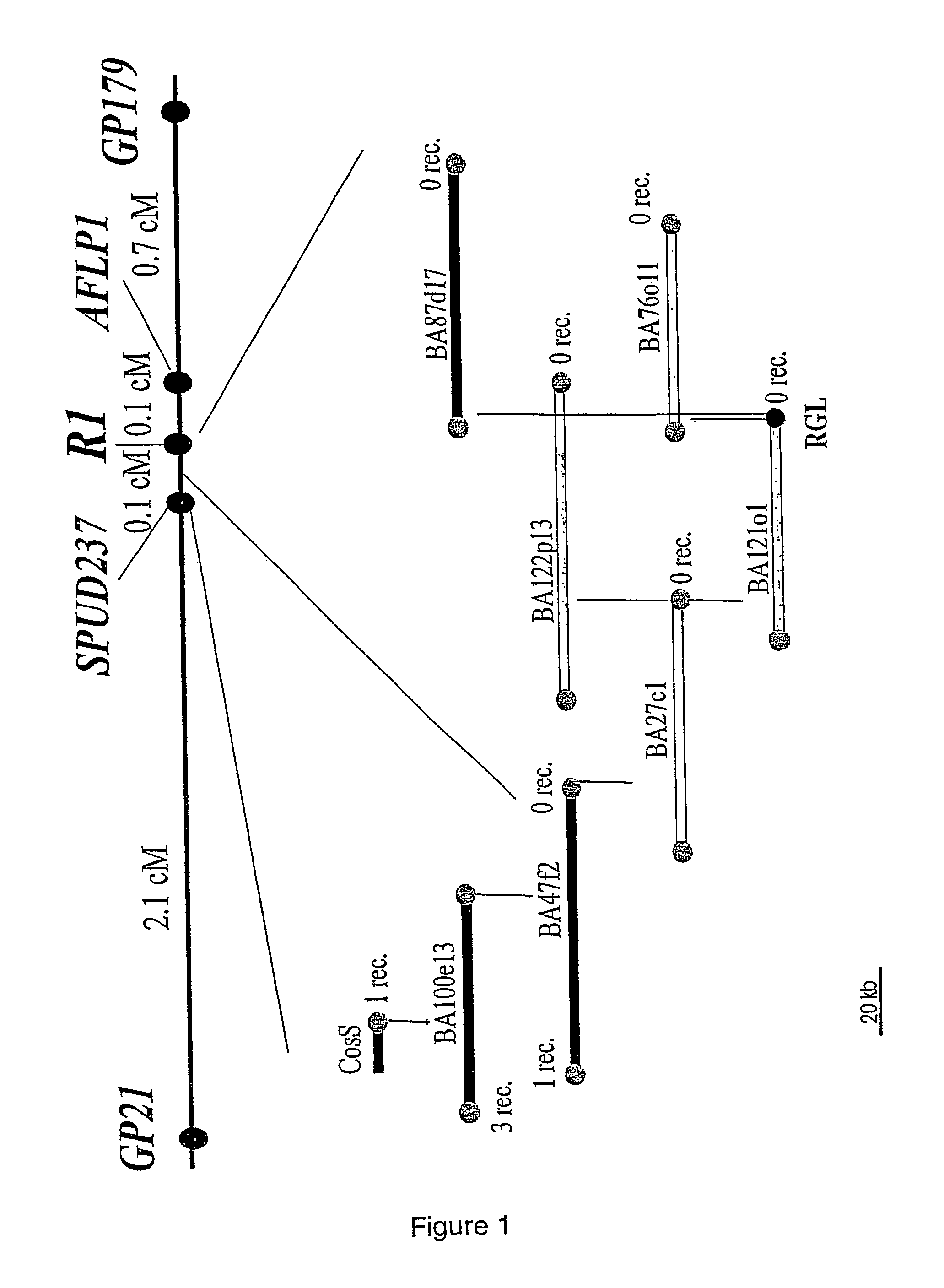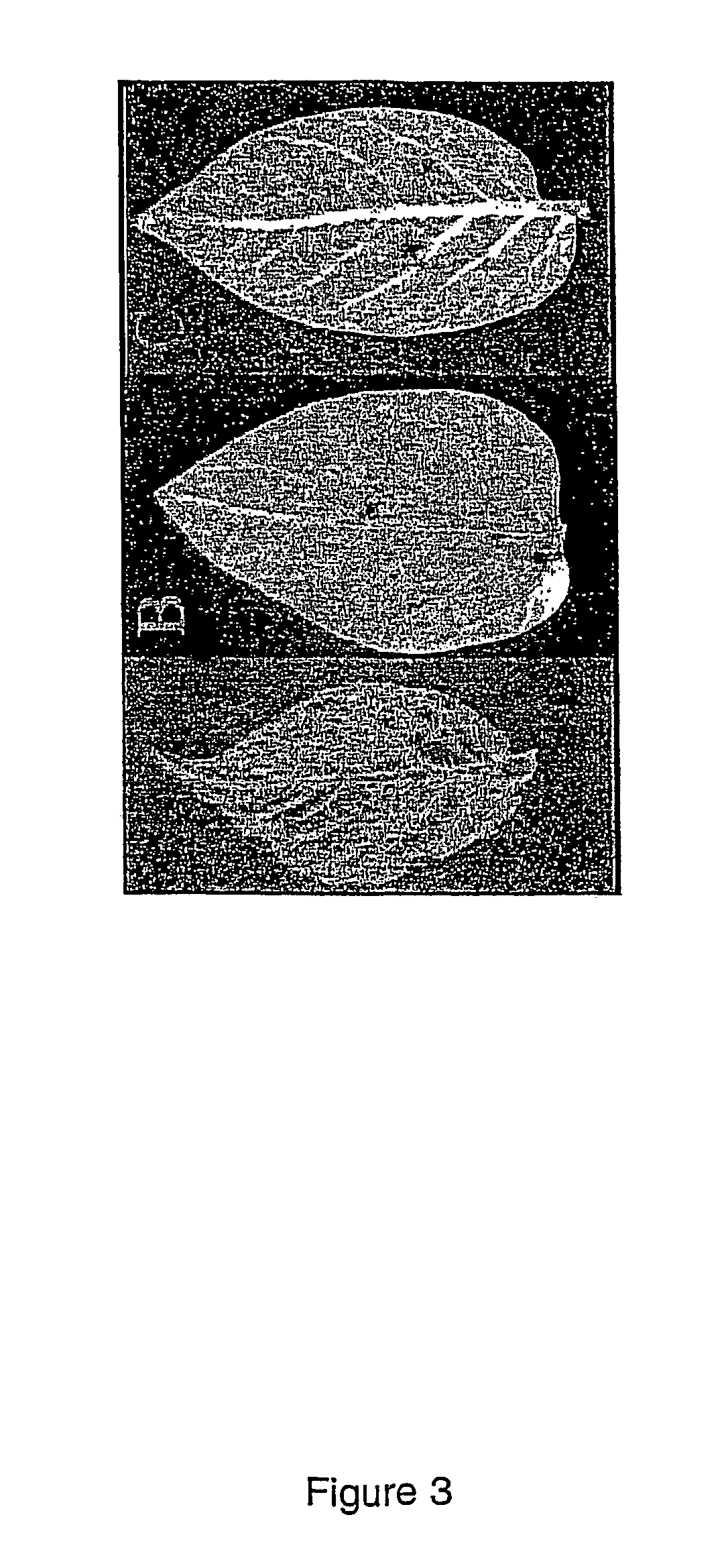Plant resistance gene
a technology of plant resistance and resistance gene, which is applied in the field of plant resistance gene, can solve the problems of unproductive walking from the marker aflp1 and achieve the effects of reducing the net negative charge of the region, efficient cloning, and altering the activity of the peptid
- Summary
- Abstract
- Description
- Claims
- Application Information
AI Technical Summary
Benefits of technology
Problems solved by technology
Method used
Image
Examples
example 1
High-Resolution Genetic Mapping of the R1 Locus
[0191]To facilitate physical mapping of the R1 locus, 16 recombinants between the markers GP21 and GP179 flanking R1 (Leonards-Schippers et al. 1992) were selected from 588 plants and tested for resistance to a P. infestans having the corresponding avirulence factor Avr1. Together with 15 recombinants previously selected in the same interval (Meksem et al. 1995), 31 recombinants in total were available in the interval GP21-GP179 from 1049 plants, corresponding to 3.0% recombination frequency (3 cM). Recombination frequencies between GP21 and R1 and between R1 and GP179 were 2.2% and 0.8%, respectively (Table 1).
[0192]
TABLE 1Number of recombinant individuals in the intervals GP21-R1,GP179-R1 and GP21-GP179, selected among 1049 plants of asegregating F1 population.GP21-R1GP179-R1GP21-GP179Number of recombinants23831Recombinants with genotype12416R1r1Recombinants with genotype11415r1r1Recombination frequency (%)2.20.83.0
[0193]The markers S...
example 2
Chromosome Walking Towards the R1 Locus and Identification of an R1 Candidate Gene
[0194]Marker SPUD237 was used as probe for screening the cosmid library. One positive clone CosS (FIG. 1) was identified. End sequencing of the CosS insert generated a new marker separated by one recombination event (0.1 cM) from the R1 locus. Screening the BAC library with this marker identified BAC clone BA100e13. Three recombination events separated the distal end of BA100e13 from R1. The BA100e13 end proximal to R1 identified BA47f2. The BA47f2 end distal to R1 overlapped with BA100e13 and was separated from R1 by one recombination event. The proximal end co-segregated with R1, like all subsequent BAC ends analysed (right part of FIG. 1). The BA47f2 end that co-segregated with R1 identified clone BA27c1. The BA27c1 end not overlapping with BA47f2 identified clones BA122p13 and BA121o1. The end of BA121o1 that did not overlap with BA27c1 showed highly significant sequence similarity (37% identity, 5...
example 3
R1 Candidate cDNA Clones
[0196]Using the whole insertions of BACs BA121o1 and BA76o11 as probes, six and eight cDNA clones, respectively, were isolated from a cDNA library prepared from infected leaves of genotype P41 (R1r1). Eight of the 14 cDNA clones were similar to known plant resistance genes. The highest similarity was obtained with the tomato Prf gene for resistance to Pseudomonas syringae (Salmeron et al. 1996). The sequences of the eight candidate cDNAs shared ca. 80-90, % identity among each other. The cDNA clone c76-2, 2292 nucleotides long, was identical, with exception of the introns, to the genomic sequence of clone g10, a subclone representing part of BA87d17 (see later). Sequence comparison to known resistance genes in the database indicated that c76-2 was not full length. Using RACE analysis, the cDNA was extended to the 0.5° end by 1943 nucleotides, resulting in a full-length cDNA sequence of 4235 nucleotides including a 5′ untranslated region of 59 nucleotides and ...
PUM
| Property | Measurement | Unit |
|---|---|---|
| Tm | aaaaa | aaaaa |
| pH | aaaaa | aaaaa |
| pH | aaaaa | aaaaa |
Abstract
Description
Claims
Application Information
 Login to View More
Login to View More - R&D
- Intellectual Property
- Life Sciences
- Materials
- Tech Scout
- Unparalleled Data Quality
- Higher Quality Content
- 60% Fewer Hallucinations
Browse by: Latest US Patents, China's latest patents, Technical Efficacy Thesaurus, Application Domain, Technology Topic, Popular Technical Reports.
© 2025 PatSnap. All rights reserved.Legal|Privacy policy|Modern Slavery Act Transparency Statement|Sitemap|About US| Contact US: help@patsnap.com



